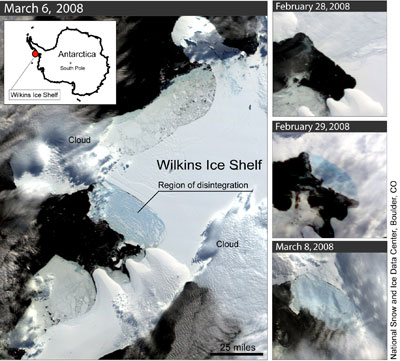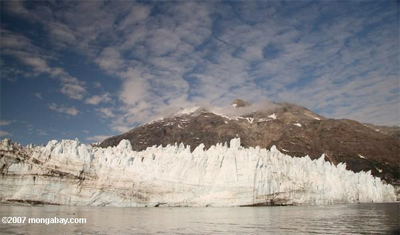|
|
Sea levels will rise faster than previously estimated due to rapid melting of glaciers and ice sheets, according to a U.S government report released at the annual meeting of the American Geophysical Union in San Francisco.
The report, titled Abrupt Climate Change, incorporates research published since last year’s Intergovernmental Panel on Climate Change (IPCC) report, which drew largely from studies dating up to 2006. Most significantly, Abrupt Climate Change suggests that IPCC estimates for future sea level rise (18-58 cm) are conservative, noting that recent observations on sea level rise and loss of sea ice are far outpacing previous projections.
“We simulate the future changes with our climate models, but those models have not always incorporated some of our latest data and observations,” said Peter Clark, a professor of geosciences at Oregon State University and a lead author on the report. “We now have data on glaciers moving faster, ice shelves collapsing and other climate trends emerging that allow us to improve the accuracy of some of our future projections.”
 This series of satellite images shows the Wilkins Ice Shelf as it began to break up. The large image is from March 6; the images at right, from top to bottom, are from February 28, February 29, and March 8. NSIDC processed these images from the NASA Moderate Resolution Imaging Spectroradiometer (MODIS) sensor, which flies on NASA’s Earth Observing System Aqua and Terra satellites. Credit: National Snow and Ice Data Center/NASA  Glacier in Alaska. Photo by Rhett A. Butler |
The report focuses on abrupt climate change, which it defines as “a large-scale change in the climate system that takes place over a few decades or less, persists (or is anticipated to persist) for at least a few decades, and causes substantial disruptions in human and natural systems.” It looks at three other types of abrupt climate change that have occurred in the past: changes in the hydrologic cycle; shifts in the Atlantic Meridional Overturning Circulation (AMOC), the current that brings warm, salty water to the North Atlantic; and the rapid release of methane trapped in permafrost and deep sea sediments. It says that while none of these are likely to occur rapidly, there could be significant changes by the end of the century, including an “abrupt period of increased drought” in the American Southwest; a 25-30 decrease in the AMOC; and accelerated release of methane hydrates, further amplifying warming. However the report cautions that there is still a great deal of uncertainty about the pace and nature of abrupt climate change. Speaking at the AGU meeting the authors warned that once underway, these processes — especially the release of frozen methane and continued melting of sea ice — would be difficult to reverse in a human timescale. These shifts will be further enabled by continued warming.
“Abrupt climate change presents potential risks for society that are poorly understood,” the researchers wrote. “An overarching recommendation is the urgent need for committed and sustained monitoring of those components of the climate system identified in this report that are particularly vulnerable to abrupt climate change.”
Abrupt Climate Change. A report by the U.S. Climate Change Science Program and the Subcommittee on Global Change Research.